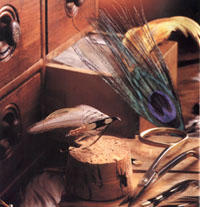|
|||
| Terms — R | |||
|
|||
|
~R ~ Versatile fur for most any color, prominent guard hairs make rabbit fur ideal for fly bodies. Hairs from foot pads are bristly and translucent. The "mask" or head and face skin from a summer killed rabbit is especially unique in the fly tier's kit. Hackle tied spider style. Salmo gairdneri, also Salmo irideus, in Britian. Also called Steelhead when sea run. Other names: California Trout, Salmon Trout, Pacific Trout, Bows and Steelies. A shiny, smooth surfaced grass used to form fly bodies. May be wrapped as quill. Usually is a tan color but may be dyed most any color. Ray Bergman, Fisherman, author and fly tier. Component parts, how much of each, order of placement, color, type of material, etc., used in the production of a fly. Provides a dark fur either brown or gray and a special creamy fur from the belly area. Red Fox tails provide a dark reddish brown streamer wing material. In hackle colors, usually refers to a brown such as used on the Royal Coachman fly. Deep shiney shade of brown. So named because of the reddish hue. The most useful feathers from this bird are found in the wings. Primaries and secondary wing feathers are excellent for winging dry flies due to their translucent quality. Body materials or dyed feathers referred to as red, are in any of the shades of red such as scarlet, crimson, cherry, etc. See - Venery Pheasant. Another name for Variants. A fly tied with the head at the bend of the hook and the tail at the eye of the hook. Purpose, to create the effect of an insect floating on the surface of moving water with it's head pointing upstream as in most natural live insects. Procedure of wrapping the hackle with the concave side forward. Provides high riding quality and keeps the fly from tipping forward. Also used in some wet flies such as the Woolly worm where reverse hackling tends to give greater action to the hackle fibers. Term for style of imitating suck of emerging insect. Hackle tip is tied in at tail to represent tail with some fibers of the hackle pulled back toward body and tied in. Resulting form appears to be partially empty nymphal case. See also - Wonder Wing. Bucktail tied in at head of fly with tips laying forward over eye. Then tips bent back over body, making a wing or a throat. Secured with tying thread about one quarter inch back of the eye. This forms a bucktail head. Used primarily in the Thunder Creek series of streamers. Spiral windings of material over the body or portions of the body. Ribbing is primarily to simulate segmentation and materials used are tinsels, threads, flosses and quills. Also used to tie down body or wing portions and to strengthen body forms. Rhode Island Red. Brown hackle. Another name for Silver Pheasant. Groundhog of the Western U.S. Hair and furs are used for winging and tails. See - Chuck Caddis. Very long and white hair, especially good for long streamer wings. Wing made of breast or flank feather tips and the fibers of which are rolled between the fingers to remove the natural curvature of the fibers, then tied in, used mainly to make double winged flies. Hackle or legs made from the commercially available white or colored rubber strands. Has an attractive motion in water. Color - Reddish brown. Term sometimes used for Butt. Term also used to designate the breast portion of feathers of a bird, such as Golden Pheasant Ruff feather (Breast). Term is also synonymous with joint and sometimes used to describe a furry head on some salmon flies. A ruff may be formed of hair, wool, fur, chenille, mohair or herls. Gray tinged with brown. Rare in natural shades. Can be produced by drying a ginger variant hackle, gray. Ginger varient dyed gray. |
 “Fly Tying Terms”
“Fly Tying Terms”